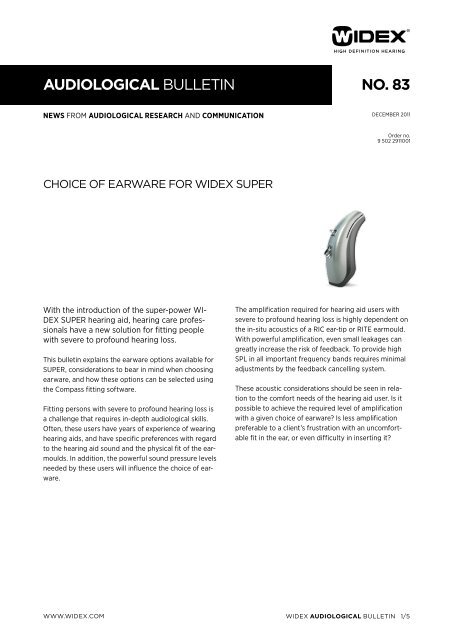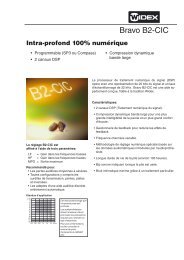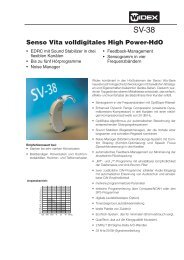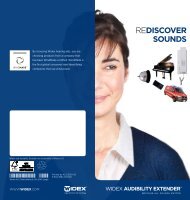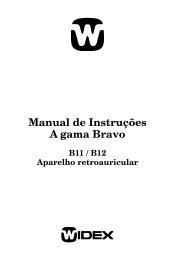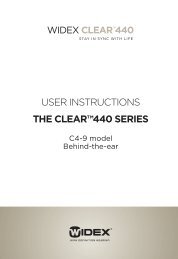choice of earware for widex SuPer
choice of earware for widex SuPer
choice of earware for widex SuPer
You also want an ePaper? Increase the reach of your titles
YUMPU automatically turns print PDFs into web optimized ePapers that Google loves.
Audiological bulletin<br />
no. 83<br />
News from Audiological Research and Communication<br />
December 2011<br />
Order no.<br />
9 502 2911001<br />
Choice <strong>of</strong> <strong>earware</strong> <strong>for</strong> WIDEX SUPER<br />
With the introduction <strong>of</strong> the super-power WI-<br />
DEX SUPER hearing aid, hearing care pr<strong>of</strong>essionals<br />
have a new solution <strong>for</strong> fitting people<br />
with severe to pr<strong>of</strong>ound hearing loss.<br />
This bulletin explains the <strong>earware</strong> options available <strong>for</strong><br />
SUPER, considerations to bear in mind when choosing<br />
<strong>earware</strong>, and how these options can be selected using<br />
the Compass fitting s<strong>of</strong>tware.<br />
Fitting persons with severe to pr<strong>of</strong>ound hearing loss is<br />
a challenge that requires in-depth audiological skills.<br />
Often, these users have years <strong>of</strong> experience <strong>of</strong> wearing<br />
hearing aids, and have specific preferences with regard<br />
to the hearing aid sound and the physical fit <strong>of</strong> the earmoulds.<br />
In addition, the powerful sound pressure levels<br />
needed by these users will influence the <strong>choice</strong> <strong>of</strong> <strong>earware</strong>.<br />
The amplification required <strong>for</strong> hearing aid users with<br />
severe to pr<strong>of</strong>ound hearing loss is highly dependent on<br />
the in-situ acoustics <strong>of</strong> a RIC ear-tip or RITE earmould.<br />
With powerful amplification, even small leakages can<br />
greatly increase the risk <strong>of</strong> feedback. To provide high<br />
SPL in all important frequency bands requires minimal<br />
adjustments by the feedback cancelling system.<br />
These acoustic considerations should be seen in relation<br />
to the com<strong>for</strong>t needs <strong>of</strong> the hearing aid user. Is it<br />
possible to achieve the required level <strong>of</strong> amplification<br />
with a given <strong>choice</strong> <strong>of</strong> <strong>earware</strong> Is less amplification<br />
preferable to a client’s frustration with an uncom<strong>for</strong>table<br />
fit in the ear, or even difficulty in inserting it<br />
www.<strong>widex</strong>.com Widex Audiological bulletin 1/5
The Output Extender<br />
For hearing-impaired persons accustomed to classic<br />
behind-the-ear hearing aids with hooks and tubing,<br />
SUPER represents an interesting alternative. Although<br />
these users <strong>of</strong>ten have conservative sound preferences,<br />
SUPER, in combination with the Output Extender, will<br />
provide a BTE-like sound quality.<br />
yield the same frequency response as the classic BTE<br />
solution. You can see the difference in maximum output<br />
<strong>for</strong> the RITE SP solutions below, with and without<br />
the Output Extender:<br />
dB SPL<br />
150<br />
140<br />
An example showing a RITE earmould with receiver<br />
housing and Output Extender sound bore:<br />
Output level<br />
130<br />
120<br />
110<br />
100<br />
90<br />
100 1000 10000 Hz<br />
Frequency<br />
RITE SP receiver with regular sound bore<br />
RITE SP receiver with Output Extender<br />
SUPER RITE SP solutions are available with a s<strong>of</strong>t earmould,<br />
a hard earmould, and a hard earmould with<br />
Output Extender.<br />
Classic BTEs use the hook and tube <strong>for</strong> sound transmission.<br />
This long sound bore introduces resonances which<br />
provide beneficial amplification behaviour <strong>for</strong> severely<br />
hearing-impaired persons. The Output Extender is a 60<br />
mm sound bore within the RITE earmould designed to<br />
The Output Extender provides greater output, especially<br />
around 1 kHz, but also in the lower frequencies. For<br />
clients with a left-hand-corner audiogram, the Output<br />
Extender can meet their needs <strong>for</strong> powerful amplification<br />
in the low frequencies.<br />
In the following comparisons <strong>of</strong> ear-tips with RIC P and<br />
RITE SP receivers <strong>for</strong> SUPER hearing aids, you will find<br />
descriptions <strong>of</strong> their acoustic per<strong>for</strong>mance, fit in ear,<br />
com<strong>for</strong>t, insertion and repeatability.<br />
www.<strong>widex</strong>.com Widex Audiological bulletin 2/5
RIC P Acoustic per<strong>for</strong>mance Insertion and repeatability Fit in ear Com<strong>for</strong>t<br />
Instant receiver<br />
tulip ear-tip<br />
Mainly <strong>for</strong> hearing losses<br />
that require relatively little<br />
amplification in the low<br />
frequencies.<br />
The placement <strong>of</strong> the eartip<br />
may vary from insertion<br />
to insertion.<br />
People with poor dexterity<br />
might find handling difficult.<br />
In some ears, the fit may<br />
not be sufficiently tight to<br />
ensure adequate acoustic<br />
per<strong>for</strong>mance.<br />
Because there is only one<br />
size, not all users may benefit<br />
from a tulip ear-tip.<br />
Very com<strong>for</strong>table.<br />
For an optimal fit, it is<br />
recommended to use an<br />
anchor.<br />
Instant receiver<br />
double ear-tip<br />
Vented ear-tip <strong>for</strong> hearing<br />
losses that require amplification<br />
across the entire<br />
frequency range.<br />
Easy to insert.<br />
Good repeatability.<br />
Due to the <strong>choice</strong> between<br />
three sizes it is possible to<br />
find a good physical fit <strong>for</strong><br />
many different ear canals.<br />
Com<strong>for</strong>table.<br />
Stays in the ear.<br />
Possibility <strong>of</strong> blocking the<br />
vent to make it acoustically<br />
closed.<br />
People with poor dexterity<br />
may find handling difficult.<br />
Custom receiver<br />
s<strong>of</strong>t ear-tip<br />
For hearing losses that<br />
require powerful amplification<br />
across the entire frequency<br />
range.<br />
Easy to insert.<br />
Good repeatability.<br />
The custom solution<br />
ensures a good fit.<br />
Com<strong>for</strong>table.<br />
Stays in the ear.<br />
Available with a concha<br />
lock. Available with a com<strong>for</strong>t<br />
vent.<br />
Custom receiver<br />
hard ear-tip<br />
For hearing losses that<br />
require powerful amplification<br />
across the entire frequency<br />
range.<br />
Easy to insert.<br />
Good repeatability.<br />
The custom solution<br />
ensures a good fit.<br />
Com<strong>for</strong>table.<br />
Stays in the ear<br />
Available with a concha<br />
lock. Available with a com<strong>for</strong>t<br />
vent.<br />
RITE SP<br />
Custom hard<br />
earmould<br />
(Output Extender)<br />
For hearing losses that<br />
require very powerful amplification.<br />
The acoustic<br />
resonances are similar to<br />
those introduced by tube<br />
and hook with classic BTE<br />
models.<br />
Easy to insert.<br />
The custom solution<br />
ensures a good fit.<br />
Com<strong>for</strong>table.<br />
For users accustomed to<br />
the sound <strong>of</strong> classic BTEs.<br />
For users accustomed to<br />
hard earmoulds.<br />
Easy to insert.<br />
Stays in the ear.<br />
Custom hard<br />
earmould (regular<br />
sound bore)<br />
For hearing losses that<br />
require very powerful amplification<br />
across the entire<br />
frequency range.<br />
Easy to insert.<br />
The custom solution<br />
ensures a good fit.<br />
Com<strong>for</strong>table.<br />
For users accustomed to<br />
hard earmoulds.<br />
Easy to insert.<br />
Stays in the ear.<br />
Wired custom s<strong>of</strong>t<br />
earmould (regular<br />
sound bore)<br />
For hearing losses that<br />
require very powerful amplification<br />
across the entire<br />
frequency range.<br />
Easy to insert.<br />
The custom solution<br />
ensures a good fit.<br />
Com<strong>for</strong>table.<br />
For users accustomed to<br />
s<strong>of</strong>t earmoulds or new<br />
RITE-style hearing aid users.<br />
Stays in the ear.<br />
www.<strong>widex</strong>.com Widex Audiological bulletin 3/5
The earwire cuff<br />
For users <strong>of</strong> SUPER, mounting the earwire cuff on the<br />
earwire may improve wearing com<strong>for</strong>t. The earwire<br />
cuff is clicked onto the earwire to provide support<br />
where the earwire rests on the outer ear.<br />
Selecting the <strong>earware</strong> solution in<br />
Compass:<br />
Make sure the hearing aids are switched on and positioned<br />
close to the connected interface. Push the ‘Detect<br />
wireless’ button and the ‘Connected hearing aids’<br />
window will open.<br />
Select the receiver: RIC P (Instant and custom ear-tip<br />
solutions), RITE SP (hard RITE earmould) or Wired SP<br />
(s<strong>of</strong>t RITE earmould).<br />
If you select RIC P, the acoustic identity will be defined<br />
as Wire flex:<br />
You can attach the earwire cuff using tweezers or round nose<br />
pliers.<br />
www.<strong>widex</strong>.com Widex Audiological bulletin 4/5
If you select RITE SP, the acoustic identity must be<br />
manually defined. Choose between ‘Wire reg. hard’<br />
or ‘Wire extender’ <strong>for</strong> a RITE solution with Output Extender.<br />
You can also define the length <strong>of</strong> the chosen earwire<br />
<strong>for</strong> future reference in the ‘Preconditions’ window, under<br />
‘Ear-set tubing’ in the ‘Acoustic conditions’ panel.<br />
If you select Wired RITE SP, the acoustic identity will be<br />
defined as Wire reg. s<strong>of</strong>t:<br />
www.<strong>widex</strong>.com Widex Audiological bulletin 5/5


